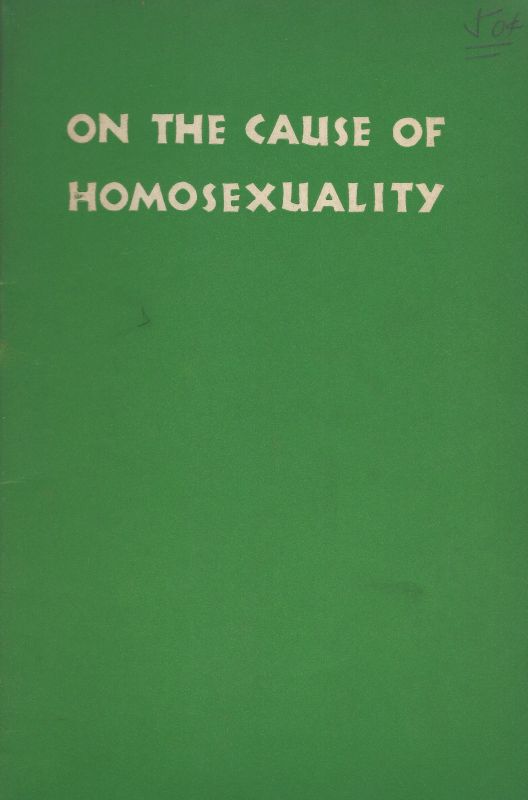Hamilton, On the Cause of Homosexuality - Two Essays, The second in reply to the
On the Cause of Homosexuality – Two Essays, The second in reply to the first. 1. Homosexuals & their Mothers / 2. Fathers & Sons.
First Edition. New York, Breaking Point, 1950. 8°. 30 pages. Original wrappers. Two stunning views on the causes of homosexuality (Incest and Castration of the Father).
At the end of this publication, Legman reflects in stunning manner on accusations made about him:
″I have been accused – by ex-hustlers, authors of homosexual fiction, and similar unbiassed observers – of shouting, in “Love & Death”, ‘The homos are coming!’ (What I said – page 91 – naming no persons, was: ‘the air is filled with shouting….″The women are coming ! Kill all the women!” ’ but let us let this particular projection of guilt pass). As I have tried to show more explicitly above, the ‘homos’ are not coming. They are going. Kinsey and his Hollerith-machine prophecies to the contrary, there is no future for homosexuality.” [Source: page 31 of the pamphlet “On the cause of Homosexuality”].
Gershon Legman (November 2, 1917 – February 23, 1999) was an American cultural critic and folklorist, best known for his books The Rationale of the Dirty Joke (1968) and The Horn Book: Studies in Erotic Folklore and Bibliography (1964).
Legman was born in Scranton, Pennsylvania, to Emil and Julia Friedman Legman, both of Hungarian-Jewish descent; his father was a railroad clerk and butcher. After a failed stab at rabbinical school Legman attended and graduated from Scranton’s Central High School, where Jane Jacobs and Cy Endfield were classmates. He enrolled in the University of Michigan for one semester in the fall of 1935, but left without sitting for his exams. He then settled in New York City where for a number of years he was a part-time freelance assistant to the physician and sexological researcher Robert Latou Dickinson at the New York Academy of Medicine while simultaneously working in the bookshop of Jacob Brussel, where a brisk business was done in publishing and selling contraband erotica; while spending long hours at the New York Public Library acquiring an autodidactic education. In the late 1940s he became the editor of the little magazine Neurotica.
Throughout his career Legman was an independent scholar without institutional affiliation, except for one year during 1964–1965 when he was a writer in residence at the University of California, San Diego, in the first year of the new campus’ undergraduate programs. He pioneered the serious academic study of erotic and taboo materials in folklore. He also was a talented raconteur and could spin out tales non-stop for hours.
As a young man he acquired a number of interests including sexuality, erotic folklore, also origami—for which he was a pivotal figure in founding the modern international movement. In 1940, at age 23, Legman wrote Oragenitalism, Part I: Cunnilinctus under the pen name Roger-Maxe de la Glannège. Nearly all copies were seized by the police and destroyed in a raid on Jacob Brussel’s shop. For a period of time, Legman was a bibliographic researcher and book scout for the Kinsey Institute.
In 1949, he published Love and Death, an attack on sexual censorship, arguing that American culture was permissive of graphic violence in proportion to, and as a consequence of, its repression of the erotic. Legman published and shipped the treatise himself, although he ran afoul of the United States Post Office Department authorities, who stopped his deliveries due to the supposed “indecent, vulgar, and obscene” content. The book also included a chapter that attacked contemporary pre-Code comic books as harmful to children for their celebration of violence, foreshadowing the later crusade against the comic book industry dominated by Fredric Wertham.
Love and Death was an outgrowth of the little magazine Neurotica, edited by Jay Landesman and published in nine issues between 1948 and 1952. Legman was a regular contributor and eventually took over from Landesman as editor. Other contributors included John Clellon Holmes, Larry Rivers, Carl Solomon, Judith Malina, Allen Ginsberg, Marshall McLuhan, and Kenneth Patchen, which gave it influence disproportionate to its small circulation of a few thousand. The magazine had a few clashes with the authorities, and closed after the censors objected to an article on castration written by Legman.
The full set of Neurotica was reprinted in one volume by Hacker Art Books, New York, in 1963. The Horn Book : Studies in Erotic Folklore and Bibliography was a collection of assorted writings from the 1950s and 1960s. Legman was a prolific writer of essays, reviews, and scholarly introductions, including those for the anonymous Victorian erotic memoir My Secret Life (1966), Aleksandr Afanasyev’s Russian Secret Tales (1966), and Mark Twain’s The Mammoth Cod (1976). He supplemented his income at times through the sale of rare erotica.
On account of his trial for violating United States Post Office regulations in his distributing his book Love and Death, Legman found it prudent to depart the United States.
In 1953 Legman left his native United States for a farm, La Clé des Champs, in the village of Valbonne in the South of France, where he was able to pursue his intellectual interests with greater freedom. In 1955 he organized an exhibition of Akira Yoshizawa’s origami at the Stedelijk Museum in Amsterdam.
Legman spent several decades compiling specimens of bawdy humor including limericks. In 1970, his first volume of over 1,700 limericks (published in 1953 by Les Hautes Etudes, Paris) was released in the United States as The Limerick. He followed this with a second volume, The New Limerick in 1977, which was reprinted as More Limericks in 1980. His magnum opus was Rationale of the Dirty Joke: (An Analysis of Sexual Humor), a tour de force of erotic folklore, succeeded by No Laughing Matter : Rationale of the Dirty Joke: An Analysis of Sexual Humor, 2nd Series, for which a subscription had to be paid to support publishing, as no publisher would touch it after Grove did volume one in 1968. Near the end of his life, Legman edited Roll Me in Your Arms and Blow the Candle Out, two volumes of bawdy songs and lore collected by Vance Randolph (both 1992). Other achievements include his edition of Robert Burns’ The Merry Muses of Caledonia (1965).
The title of Gershon Legman’s autobiography, Peregrine Penis, was a sobriquet bestowed on him by his girlfriend Louise “Beka” Doherty, on account of the fact that he “used to travel to meet her in strange places.” The writing of Peregrine Penis, over “six hundred pages” in length, was continually subsidized by Larry McMurtry.
On September 5, 2016, Book One of Gershon Legman’s autobiography became available as a print-on-demand, two-volume set, carefully edited by Judith Evans Legman (G. Legman’s widow), under the title I Love You, I Really Do. On March 8, 2017, Book Two appeared in a third volume, under the title Mooncalf, which continues the story of Legman’s life up to the eve of World War II. Book Three, World I Never Made, was released in a fourth volume in August 2017. A fifth volume, Musick to My Sorrow, was published in March 2018, and a sixth volume, Windows of Winter & Flagrant Delectations, appeared in October 2018.
Legman was in many senses a radical, but never identified with the movements of his time, decrying the sexual revolution, for example, in The Fake Revolt (1967), and leaving countless irascible obiter dicta on such topics as women’s liberation, rock and roll and the psychedelic movement’s use of mind-altering substances. However, he said he was the inventor of the famous phrase “Make love, not war”, in a lecture given at the Ohio University in 1963. He remained essentially an individualist and an idealist: “I consider sexual love the central mystery and central reality of life”, he wrote. And “I believe in a personal and intense style, and in making value judgements [sic]. This is unfashionable now, but is the only responsible position”. Mikita Brottman offers the consensus view of Legman as, in many ways, his own worst enemy, exacerbating his rejection by the academic community with vitriolic attacks upon it.
In Bruce Jackson’s view “Legman is the person, more than any other, who made research into erotic folklore and erotic verbal behavior academically respectable” and who made accessible to other scholars material that scholarly journals had long been afraid to publish.
Gershon Legman died February 23, 1999, in his adopted home country, France, after several years of debility, and a week after suffering a massive stroke.
According to historian George Chauncey’s book Gay New York: Gender, Urban Culture, and the Making of the Gay Male World, 1890–1940, Legman was gay and is credited with having invented the vibrating dildo when he was only twenty. However, Mikita Brottman holds that he was exclusively heterosexual, accounting for both the abandonment of his proposed volume on fellatio as well as, possibly and in some measure, for his contempt for Alfred Kinsey. He was married for many years to Beverley Keith (died of lung cancer, 1966), married briefly to Christine Conrad, ended by annulment, then to Judith Evans. (Wikipedia)
- Keywords: Catalogue Nine – Medicine · Catalogue Twelve – Philosophy · Gay · Homosexualität · Homosexuality · Legman, Gershon · Philosophy Rare · Psychology – Rare
- Language: English
- Inventory Number: 17631AB
EUR 175,--
© 2024 Inanna Rare Books Ltd. | Powered by HESCOM-Software











